This website uses cookies as well as similar tools and technologies to understand visitors’ experiences. By continuing to use this website, you consent to Columbia University’s usage of cookies and similar technologies, in accordance with the Columbia University Website Cookie Notice.
Energy Explained
Insights from the Center on Global Energy Policy
This Energy Explained post represents the research and views of the author. It does not necessarily represent the views of the Center on Global Energy Policy. The piece may be subject to further revision. Contributions to SIPA for the benefit of CGEP are general use gifts, which gives the Center discretion in how it allocates these funds. Rare cases of sponsored projects are clearly indicated.
For a full list of financial supporters of the Center on Global Energy Policy at Columbia University SIPA, please visit our website at Our Partners. See below a list of members that are currently in CGEP’s Visionary Circle. This list is updated periodically.
Saudi Arabia is experiencing a significant economic transformation under its Vision 2030 plan to reduce the country’s dependence on oil revenues by diversifying its economy. The Saudi government’s introduction of a value-added tax (VAT) and successful debt issuances have already diversified revenue sources, lowering oil’s share of total revenue to below 70 percent, even during periods of high oil prices.[1] But challenges remain. Saudi Arabia’s fiscal break-even oil price—the price per barrel needed to balance the budget—has risen, indicating continued sensitivity to oil price fluctuations. Its external break-even oil price has also increased, reflecting ongoing reliance on oil exports to finance imports. These challenges underscore the need for policies that enhance fiscal resilience, particularly in the face of potential future oil shocks.[2]
One approach Saudi Arabia has adopted is investing heavily in renewable energy, particularly through partnerships with China. This has had the effect of accelerating the country’s progress in renewable energy, with far-reaching implications for global geopolitics and energy markets. Specifically, Saudi Arabia is increasingly becoming aligned with China while China is gaining greater access to Middle Eastern markets and greater regional influence.
Saudi Arabia’s Renewable Energy Ambitions
Saudi Arabia has established a goal to source at least 50 percent of its power from renewable energy by 2030, expanding its capacity to 130 gigawatts (GW), 58.7 GW of which is expected to come from solar and 40 GW from wind.[3] This target is the most ambitious of its kind among Gulf Cooperation Council (GCC) countries (Figure 1).
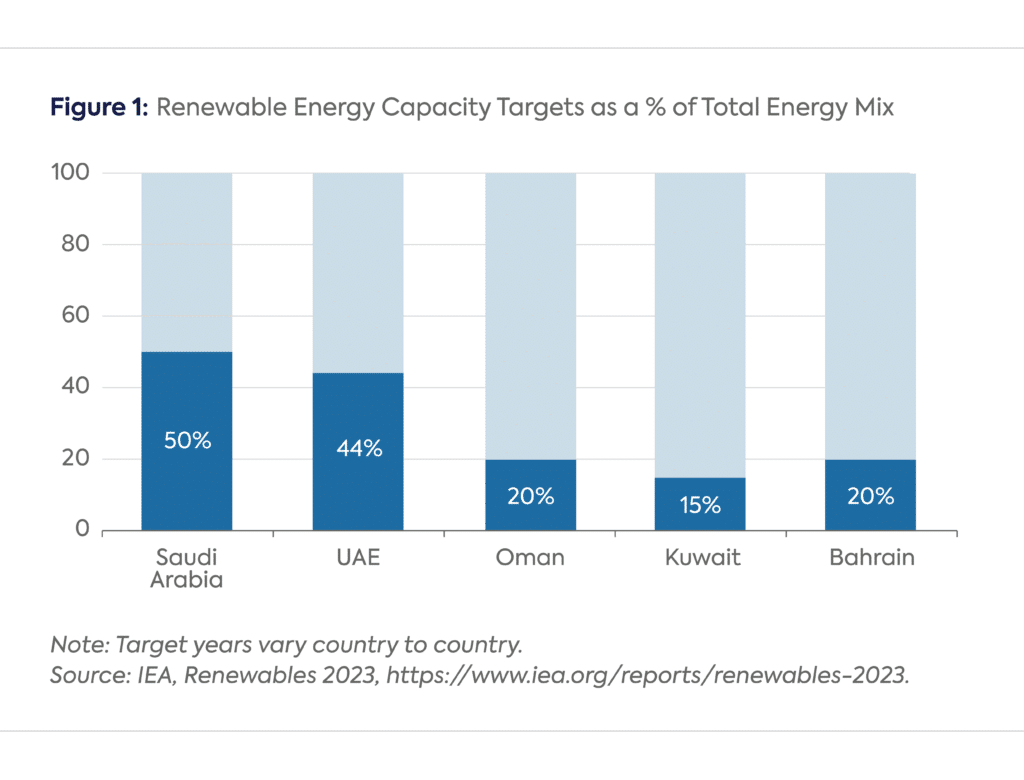
To achieve it, Saudi Arabia is prioritizing a range of renewable energy production and infrastructure initiatives (Table 1).
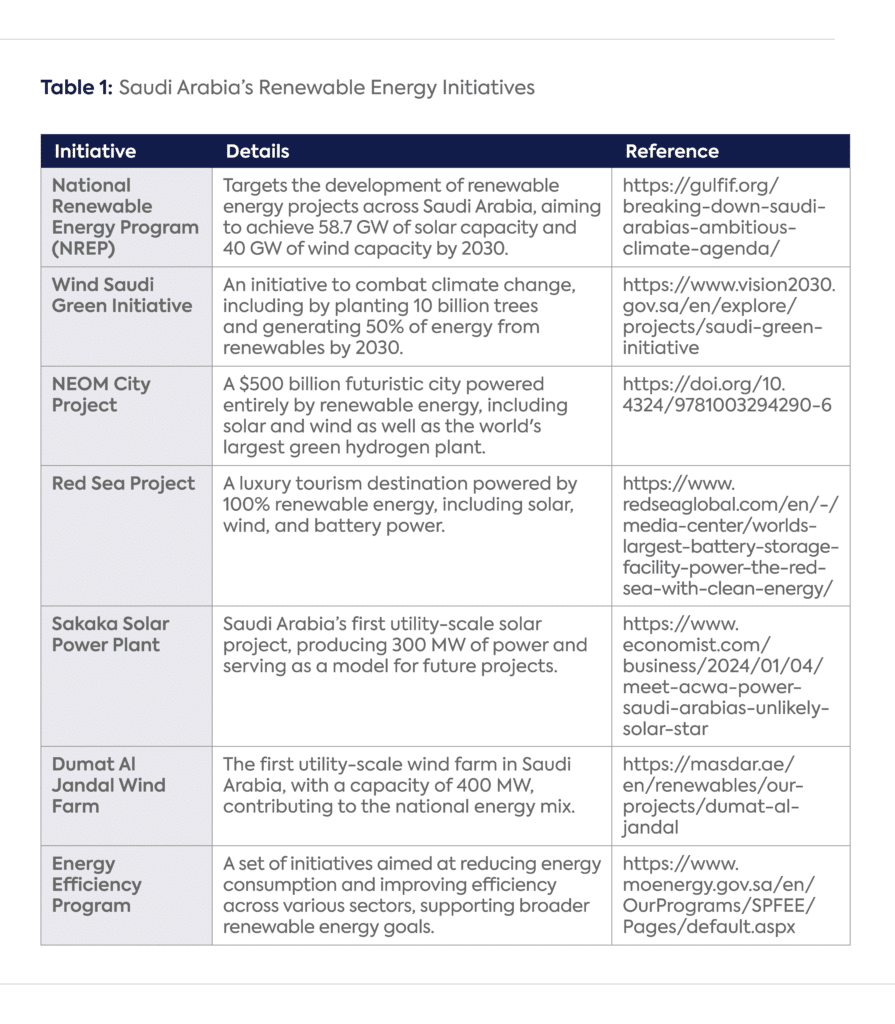
Saudi Arabia intends to use the renewable capacity it develops from these initiatives not only to power the country but also to export renewable energy to the world.[4]
New Strategic Partnerships and Their Geopolitical Implications
Saudi Arabia has also been forming significant partnerships with leading Chinese renewable energy companies undergirded by substantial investments (Table 2).
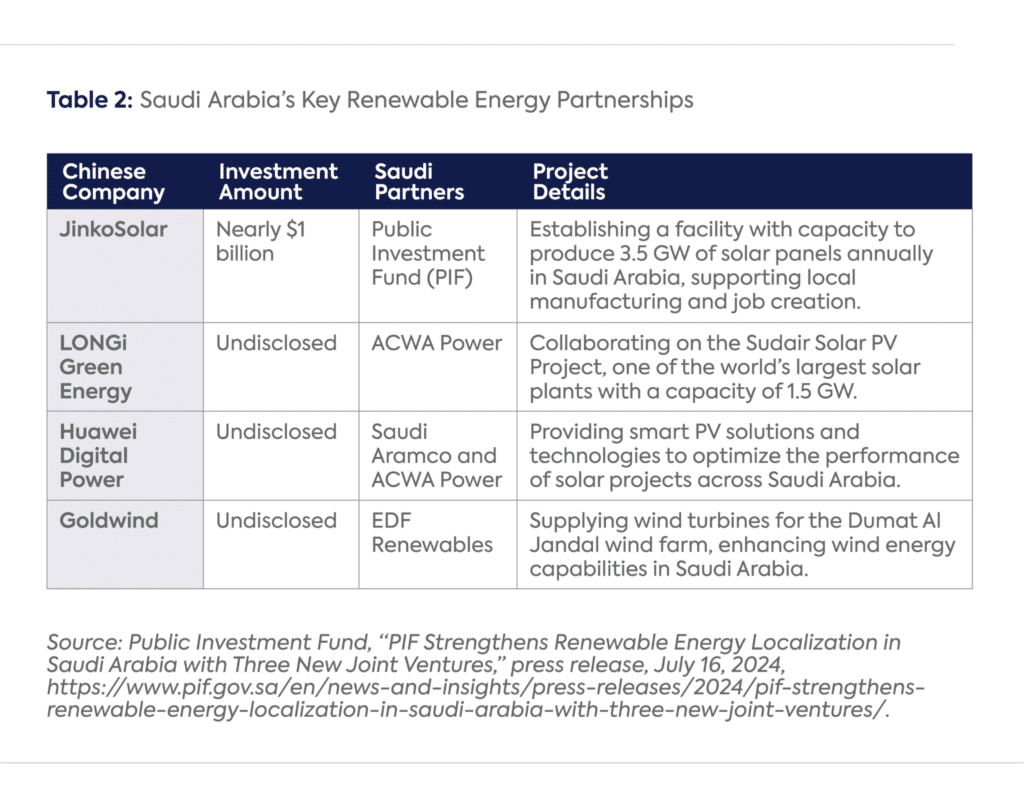
These partnerships provide Saudi Arabia with advanced technology and financing options while allowing China to secure vital energy resources, strengthen its Belt and Road Initiative, and gain greater access to Middle Eastern energy markets.
Saudi Arabia’s new alignment with China on renewable energy could have powerful and lasting geopolitical implications. Through this relationship, China is expanding its influence in Saudi Arabia and the broader Middle East region. This poses a major strategic challenge to the United States, which has long been a key strategic partner and ally to Saudi Arabia and the dominant external player in the region. If the US intends to maintain its regional foothold going forward, US policymakers may want to consider how they can enhance economic engagement with and/or offer competitive partnerships to Saudia Arabia and other nearby countries.
Moreover, Saudi Arabia’s localization efforts, supported by Chinese partnerships, could significantly alter global supply chains in the clean energy sector. The country aims to transition from a renewable technology importer to a renewable technology exporter, potentially making the Gulf region a central hub for renewable energy components.[5]
Conclusion
Saudi Arabia’s aggressive investment in renewable energy and strategic partnerships, particularly with China, represent a significant development with global implications. The move aligns with the country’s goal of economic diversification and positions it as a potential leader in the global energy transition. By challenging traditional geopolitical alliances, it may also lead to a more multipolar balance of power in the Middle East, which in turn could prompt global powers, especially the United States, to reconsider their strategic approach to the region.
CGEP’s Visionary Circle
Corporate Partnerships
Occidental Petroleum Corporation
Tellurian Inc
Foundations and Individual Donors
Anonymous
Anonymous
the bedari collective
Jay Bernstein
Breakthrough Energy LLC
Children’s Investment Fund Foundation (CIFF)
Arjun Murti
Ray Rothrock
Kimberly and Scott Sheffield
[1] Middle East Council on Global Affairs, “Tax Reform in Saudi Arabia: Assessing the Economic and Societal Impacts,” May 2024, https://mecouncil.org/publication/tax-reform-in-saudi-arabia-assessing-the-economic-and-societal-impacts/.
[2] Khalid Alsweilem, Michael Lepech, Ashby Monk, and Malan Rietveld. “From the Big Push to the Long Push: Building Resilience Beyond Vision 2030 in Saudi Arabia,” Center for Sustainable Development and Global Competitiveness, Stanford University, 2024, https://sdgc.stanford.edu/sites/g/files/sbiybj18741/files/media/file/saudi-resilience_big-to-long-push_1_aug_24.pdf.
[3] Ali Al-Sarihi and Ugo Montero Uranga, “Renewable Energy in the Gulf Arab States,” Center for Contemporary Arab Studies, November 18, 2019, https://ccas.georgetown.edu/2019/11/18/renewable-energy-in-the-gulf-arab-states/.
[4] Saudi Press Agency, “Al-Jubeir Highlights Saudi Arabia’s Goal to Be Top Energy Supplier,” https://www.spa.gov.sa/.
[5] Abeer Abu Omar and Joumanna Bercetche, “Saudi Arabia Says Economic Revamp Momentum Intact as Plans Shift,” Bloomberg, April 29, 2024, https://www.bloomberg.com/news/articles/2024-04-29/saudi-arabia-says-economic-revamp-momentum-intact-as-plans-shift.
More on Energy Explained Energy Explained
Climate Leadership Opportunities for Brazil at COP30
As the host of COP30, Brazil has an unprecedented platform to demonstrate its climate leadership.

Six Key Issues That Defined Climate Week 2025
CGEP scholars reflect on some of the standout issues of the day during this year's Climate Week

Renewable Energy Development in the GCC: Progress Made and Challenges Ahead
Gulf Cooperation Council (GCC) countries have not only the world's lowest costs for oil and gas production but also the lowest costs for electricity generated from renewable energy sources.

3 Coming Flashpoints in Climate Geopolitics
World leaders are meeting in New York this month at the request of the United Nations Secretary-General António Guterres to discuss the state of global ambition on climate change.

Relevant
Publications
How to Win the Economic War with China
President Donald Trump’s impulsive, go-it-alone approach is uniquely ill-suited to the long-term and cross-cutting nature of the challenge that China poses.
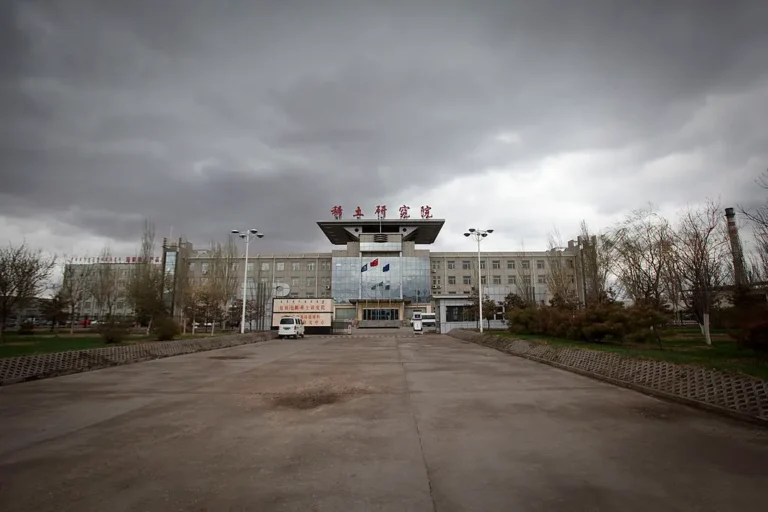
US-China Trade Tensions and Clean Energy Investment in Third Countries: Implications for US Policymakers
The global clean energy economy today looks starkly different than it did even 10 years ago. Not only have production and deployment of clean energy technologies expanded significantly, the geographic distribution of clean energy manufacturers, resellers, and end-users has shifted dramatically.
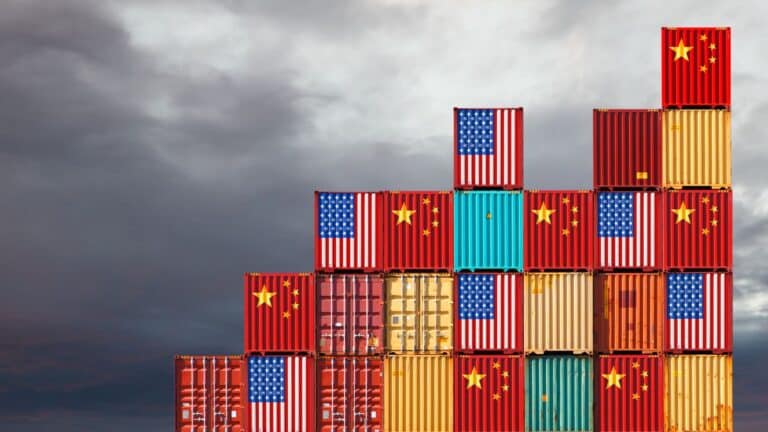
The Return of the Energy Weapon
Throughout much of the modern era, limiting or disrupting the flow of energy was a highly effective tool of global power.




